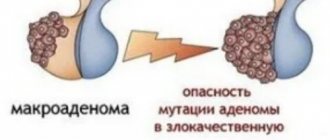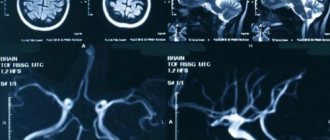Malignant neoplasms of the central nervous system are very aggressive, grow quickly and destroy brain tissue. If they are detected, it is advisable to perform surgery to remove the tumor as early as possible, before the development of severe irreversible neurological deficit.
Neurosurgeons at the NACFF clinic perform complex operations for glioblastomas and other high-grade tumors of the central nervous system. Doctors can safely remove even deep-lying tumors, since before intervention they identify functionally important areas of the brain so as not to damage them during surgery.
Is there a cure for a brain tumor?
Non-surgical methods of therapeutic treatment for intracranial tumors often play a leading role in the treatment process, since it is not always possible to cure a brain tumor with surgery. Often, according to the results of imaging diagnostics, the neoplasm is located in functionally active areas, and its physical removal is associated with risks to the patient’s life.
Is a brain tumor curable without the help of surgeons? Yes, there are many new therapy methods that can significantly affect the patient’s life expectancy.
Whether a brain tumor can be treated depends on its degree of malignancy. According to the classification, there are four such degrees in total.
As a rule, it is possible to cure a brain tumor completely if it is benign ( grade 1 ). The risk of relapse is very low.
Grade 2 is also considered benign , but the prognosis is worse. Whether a brain tumor of the second degree of malignancy can be cured largely depends on the therapeutic methods used and the age of the patient - the older the person, the worse the prognosis. On average, the relapse-free period after treatment lasts 3-5 years.
Starting from grade 3 , the neoplasm is considered malignant and metastasizes. Is it possible to cure a malignant brain tumor? Unfortunately, even surgery does not lead to a complete cure in most cases. The risk of recurrence depends on whether the tumor is completely removed.
Finally, the highest malignancy is characterized by a neoplasm of grade 4 malignancy. Most often it is glioblastoma. This type of cancer occurs quite often. The prognosis is unfavorable. The answer to the question whether a stage 4 brain tumor can be cured is clearly negative. The life expectancy of patients without surgery is only 4-12 months. True, in recent years, new methods have emerged in developed countries, including alternative medicine and alternative medicine, which can extend the patient’s life by several years without the use of surgical methods.
Select a clinic and treatment
What are the symptoms?
The initial stages of the disease are almost asymptomatic, which makes its early diagnosis difficult.
Symptoms that appear as they progress are cerebral and neurological.
General cerebral ones are associated with increased intracranial pressure and increased intoxication:
- severe headaches that get worse when lying down;
- nausea not associated with food intake and vomiting that does not bring relief;
- constant dizziness;
- general weakness, increased fatigue, drowsiness;
- some lethargy, decreased intellectual abilities and memory;
- apathy, depression, irritability.
Neurological manifestations depend on where the lesion is located and can manifest as:
- speech, hearing, and vision disorders;
- seizures;
- paralysis or sensory impairment of the limbs;
- coordination disorders (vestibular syndrome);
- respiratory depression;
- auditory and tactile hallucinations.
The similarity of neurological symptoms with stroke symptoms sometimes causes misdiagnosis.
Radiation therapy
The basis of non-surgical treatment for brain tumors is radiation therapy. Radiosurgical and radiotherapeutic methods are used. Radiosurgery involves the introduction of radioactive substances into the brain. Radiotherapy involves external beam radiation.
Brain tumors are treated with radiation therapy in the following cases:
- After surgery to reduce or delay the risk of recurrence
- As a palliative treatment to reduce the size of the tumor and relieve symptoms
- As an independent method of treatment, if surgery is not performed for some reason
There are many reasons why surgical treatment may not be used. Most often, refusal of surgery is due to the location of the tumor. It is often localized in hard-to-reach or vital areas (for example, the brain stem). Therefore, removal carries a risk to the patient's life or creates significant neurological deficits.
There are other reasons:
- Patient's refusal to undergo surgery
- Presence of medical contraindications
- Low life expectancy
- Financial reasons (the operation is not cheap)
In many cases, the large size of the tumor and the high degree of malignancy of the cancer cause doctors to refuse surgery, because treating a brain tumor with surgery is equally effective in terms of prognosis as using radiation therapy alone. At the same time, irradiation, while providing a similar life expectancy, does not carry as many risks for the patient and is much easier to tolerate.
The following types of radiation therapy for brain tumors are currently used:
- External beam radiation therapy . Same as x-ray, only the radiation dose is much higher. Before radiation, an MRI or CT scan is performed to determine the exact location of the formation. Sessions last 15-30 minutes. This is the simplest method, long used in oncology. It has a big drawback: the tissues surrounding the tumor also receive a fairly large radiation dose.
- Three-dimensional conformal radiation therapy . A more advanced method of irradiation, allowing to minimize the radiation dose to healthy tissues. MRI is used to accurately determine the location of the tumor. Then many beams of gamma rays are directed at it from different directions. Each of them carries a minimal radiation load. But there are many such beams, and they all focus on the tumor.
- Intensity modulated radiation therapy . An even more modern method of 3D radiation therapy, which involves the possibility of controlling the radiation dose. Thanks to this technique, the doctor can increase the radiation dose to the tumor and reduce it to healthy tissue, which is most sensitive.
- Stereotactic radiosurgery . Used as an alternative to surgery. With the help of stereotactic radiosurgery, it is possible to cure a brain tumor of a difficult-to-reach localization in one or several sessions of high-precision and high-dose radiation. Gamma Knife or Cyber Knife installations are used. Today, this type of treatment has become more comfortable for the patient, because thanks to the precise targeting of the beams, therapy can be carried out without the use of stereotactic frames.
- Proton therapy . Uses positively charged particles instead of X-rays. It is characterized by high safety, since healthy tissues are practically not damaged. In this case, the tumor receives a large dose of radiation. The disadvantage of this method is the high cost of treatment.
Whether a brain tumor can be cured with radiation therapy alone depends on its grade. With benign neoplasms, it is usually possible to achieve a fairly long life expectancy for the patient. Tumors may not recur at all after treatment, or the relapse-free period may last 5-10 years or more. But with malignant tumors, the disease does not go away forever, since it is almost impossible to stop the growth of a brain tumor without the risk of relapse using radiation therapy alone. This method is less effective than surgical treatment. Its advantage lies only in a higher safety profile and better tolerability of treatment.
Select a clinic and treatment
Prevention recommendations
Cancer can affect anyone, including people who lead a healthy lifestyle. In a word, no one is immune from the disease. However, following simple medical recommendations will help to significantly reduce the risk of disease:
- Eat right. The diet should include more fresh vegetables, meat, fish, and dairy products. Store-bought sweets, soda, packaged juices and fast food are recommended to be excluded from the diet.
- Drink more water. The norm of fluid consumption is at least one and a half liters per day.
- Don't forget about physical activity. But you shouldn’t overuse them either: daily walks in the fresh air and morning exercises are enough.
- Give up bad habits. Alcohol and smoking provoke cell mutations.
And of course, do not forget to visit your doctor on time. Annual medical examinations can help identify the disease in its early stages.
Chemotherapy
Chemotherapy in the treatment of brain tumors is much less important than in the treatment of other cancers. The reason is that the brain is separated from other organs and systems by the blood-brain barrier. Most existing chemotherapy drugs cannot overcome it. Consequently, after they are introduced into a vein or taken orally, the drugs simply do not reach the tumor tissue and cannot affect it.
When is chemotherapy used to treat brain tumors:
- If the tumor grows very quickly
- If surgery has not been used, chemotherapy may be used in combination with radiation therapy
- If surgery was performed, chemotherapy drugs are injected through a catheter directly into the ventricle of the brain, thus breaking the blood-brain barrier
- If the patient is diagnosed with lymphoma or medulloblastoma, these types of tumors respond better to chemotherapy
But more often, brain tumor treatment occurs without the use of chemotherapy. They are often poorly tolerated by the patient, without increasing life expectancy and having a minimal effect on tumor growth.
Targeted therapy
For some types of tumors, targeted therapy drugs are used. Among them:
Angiogenesis inhibitors . Monoclonal antibodies are used that block vascular endothelial growth factor. The tumor is constantly growing and must receive nutrients from the blood vessels. But an angiogenesis inhibitor blocks the growth of arteries that feed the tumor. The tumor does not receive enough nutrients, and its growth slows down.
Research has shown that angiogenesis inhibitors can be used in the treatment of glioblastoma after surgery to delay recurrence. These drugs do not significantly affect life expectancy. But they make it possible to reduce the dosage of steroid hormones used (a drug that prevents brain swelling), which are not always well tolerated by patients.
mTOR protein inhibitors . This is a protein that helps the tumor increase its mass. Drugs that block it are used in the treatment of astrocytoma. They slow down its growth for quite a long time. Treatment of brain tumors with mTOR inhibitors increases patient life expectancy.
Diagnosis of glioblastoma
To make and clarify the diagnosis of glioblastoma in the presence of symptoms, specialists prescribe instrumental studies :
- MRI of the brain or spinal cord;
- magnetic resonance spectroscopy and/or perfusion;
- computed tomography;
- positron emission tomography of the brain;
- stereotactic biopsy using computer navigation systems.
For laboratory diagnostics use:
- histological typing;
- molecular test;
- immunohistochemical study;
- analysis of gene activity (methylation of the MGMT gene).
Find out the price
Find out the price
Error! Please fill in all required fields
Thank you! We will contact you shortly
✕
Can't fly to Turkey right now? Sign up for an online consultation with an Anadolu specialist.
Electric field therapy
Treatment for a brain tumor involves more than just radiation and drugs. Alternating electric field therapy has begun to be used more and more often. Studies have shown that it inhibits the growth of tumor cells, with virtually no effect on healthy tissue. This treatment of a brain tumor allows the patient to live longer. Moreover, it is safe and free of serious side effects.
Alternating electric field therapy is used for glioblastoma. This is a fast-growing and very dangerous tumor of grade 4 malignancy. Since treating a malignant brain tumor with chemotherapy alone is not always successful, electric field treatment can serve as an addition to chemotherapy.
The essence of the method is that four electrodes are attached to the patient’s head. The batteries are located in a backpack, which a person constantly carries with him. This treatment of a brain tumor, combined with chemotherapy, prolongs life by an average of more than 20 months.
Why does glioblastoma appear?
The causes of glioblastoma, like most cancers, are not precisely known. It is believed that the disease is associated with a mutation of certain genes.
It was possible to identify some factors that may increase the risk of tumor development. These include:
- hereditary predisposition;
- previous traumatic brain injury;
- other brain tumors, especially astrocytomas;
- neurofibromatosis;
- exposure to ionizing radiation;
- cytomegalovirus, herpes IV and other viral infection.
Symptomatic treatment
Not every brain tumor is curable. Sometimes the goal of therapy is not the patient’s recovery, but the elimination of the main symptoms of the disease in order to improve his quality of life. Symptomatic medications always complement the main treatment of a brain tumor.
The following medications are used:
- Corticosteroids – relieve headaches, eliminate inflammation after radiation therapy, prevent brain swelling
- Anticonvulsants – reduce the number of seizures in people with brain tumors
- Hormonal treatment – used for hormone-producing tumors (for example, pituitary tumors) to correct metabolic disorders
Specialized clinics and treatment costs
Non-surgical treatment of brain tumors is usually carried out in the departments of neurosurgery or interventional neuroradiology. In this case, the patient remains under the supervision of neurologists and neurosurgeons during his hospital stay. Leading clinics that offer minimally invasive and non-surgical treatment for brain tumors:
- University Clinic named after. Goethe Frankfurt am Main, Department of Adult and Pediatric Neurosurgery
- University Hospital Rechts der Isar Munich Department of Adult and Pediatric Neurosurgery
- University Hospital Münster, Department of Neurosurgery
- Charité University Hospital Berlin, Department of Adult and Pediatric Neurosurgery
- Beta-Klinik Bonn, Department of Neurosurgery and Interventional Neuroradiology
- University Hospital Freiburg, Department of Adult and Pediatric Neurosurgery
The cost of non-surgical treatment of brain tumors depends on the diagnosis, the chosen technique, and the level of the clinic. Estimated prices for various treatment methods are:
- Non-invasive removal of tumors with the Gamma Knife system – from 10,935 euros
- Laser ablation under MRI control – from 57,985 euros
- Proton therapy – from 45,000 euros
- Chemotherapy and radiation therapy – from 24,500 euros
- Neurological rehabilitation after completion of the main course of treatment – from 540 euros per day
Select a clinic and treatment
Treatment in Germany
Each person decides for himself where to treat a brain tumor, based on his financial capabilities. Oncology and neurosurgery are very knowledge-intensive and therefore expensive branches of medicine.
Obviously, it is better to undergo treatment and subsequent rehabilitation in clinics in developed countries such as Germany. All the most modern therapeutic methods are available there: the latest types of radiation therapy, stereotactic radiosurgery, targeted therapy and others.
Many patients have problems organizing travel abroad for therapy. All organizational issues can be taken care of by ]Booking Health[/anchor], a medical tourism operator that has been organizing treatment for patients from 75 countries in leading clinics in the world for more than 10 years.
Booking Health specialists will help you with such important points:
- Choosing the right clinic based on the annual qualification profile
- Direct communication directly with the attending physician
- Preliminary preparation of a treatment program without repeating previously conducted examinations
- Ensuring favorable prices for clinic services, without surcharges and coefficients for foreign patients (savings up to 50%)
- Make an appointment for the desired date
- Control of the medical program at all stages
- Assistance in purchasing and shipping medications
- Communication with the clinic after completion of treatment
- Control of invoices and return of unspent funds
- Organization of additional examinations
- Service of the highest level: booking hotels, plane tickets, transfers
- Translator and personal medical coordinator services
We are leaders in the field of medical tourism. We have direct contracts with all major clinics in Germany. Therefore, you can use the services of the best doctors in the world at affordable prices.
Select a clinic and book a medical program yourself or leave a request on the website to receive help from a medical consultant.









